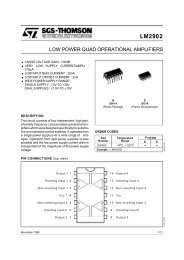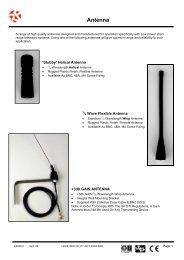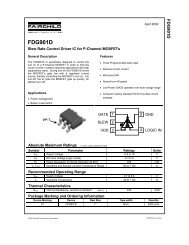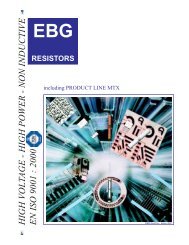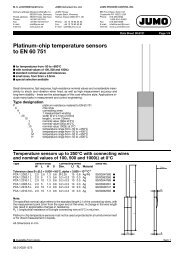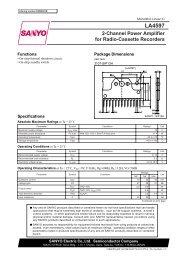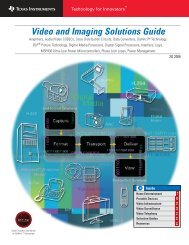10 RS-485/422 ➔ Design Considerations Robustness — RS-485 is a robust interface standard for use in industrial environments. It features a wide common mode range of –7 V to 12 V. Parts from TI are available with ESD protection up to 16 kV. Reliability — Integrated fail-safe circuitry protects the bus from interpreting noise as valid data when short-circuit, opencircuit or idle line fault conditions occur. Speed and Distance — Low noise coupling of differential signaling with twisted-pair cabling and wide commonmode voltage range allows data exchange at signaling rates of up to 50 Mbps or to distances of several kilometers at lower rates. RS-485/422 Family of Products Line Loading — RS-422 is capable of supporting one driver and up to 10 receivers on the bus line. Standard RS-485 is capable of supporting up to 32 unit loads or nodes on the bus line. However, there are reduced unit load devices available that can support up to 256 devices. Termination — A multipoint bus architecture requires termination at both ends of the bus line. The termination resistors must be within 20 percent of the characteristic impedance of the cable and can vary from 90 Ω to 120 Ω. Resources Technical Information • The main difference between RS-422 and RS-485 is the multidrop and multipoint bus architecture—that is, one driver to many receivers and many drivers to many receivers, respectively. • Typical signaling rates and distances for these standards are up to 10 Mbps or up to 1.2 km. TI offers devices capable of reaching signaling rates of up to 50 Mbps. For a complete list of resources (data sheets and application notes), visit interface.ti.com Literature Number Description Application Notes SLLA036B <strong>Interface</strong> Circuits for TIA/EIA-485 (RS-485) SLLA070C 422 and 485 Standards Overview and System Configurations SLLA112 RS-485 for E-Meter Applications SLLA106 TIA/EIA-485 and M-LVDS, Power and Speed Comparison SLLA067 Comparing Bus Solutions SLLA143 RS-485 for Digital Motor Control Applications Note: IBIS models are available at interface.ti.com Quads ALS172A/173 ALS174A/175 LBC172A/173A ◆ LBS174A/175A ◆ Triples Duals ALS170/171A LBC170/171 ◆ ALS1177 ALS1178 5-V Supply Voltage 3.3-V Supply Voltage ◆ ≥ 30 Mbps ■ > 32 Nodes On Bus Singles IEC ESD ESD≥15kV ALS176B ◆ LBC176A ◆ HVD1176 ■ LBC182/184 ■ HVD308xE ● ■ HVD485 ● ■ HVD0x ◆ ■ HVD2x ■ HVD1x ◆ ▲ Profibus IEC Transcient Voltage Suppression Increased Noise Margin Longer Distances ESD≥15kV ALS179 ALS180 ALS181 LBC179A ◆ LBC180A ◆ HVD5x ◆ ■ HVD3x ◆ ■ Preview Half-Duplex Tranceivers Full-Duplex Tranceivers Drivers/ Receivers <strong>Interface</strong> <strong>Selection</strong> <strong>Guide</strong> Texas Instruments 3Q 2005
RS-485/422 11 RS-485/422 <strong>Selection</strong> <strong>Guide</strong> No. Supply I CC Signaling Temperature of Voltage Max Rate ESD Prefix 1 Device Description Tx/Rx (V) (mA) (Mbps) (kV) Fail Safe Nodes Footprint Pin/Package(s) Price 2 SN65, SN75 HVD12 3.3-V Transceiver — 1 Mbps 1/1 3.3 15.5 1 16 Short, Open 256 SN75176 8PDIP, 8SOIC 1.65 SN65, SN75 HVD11 3.3-V Transceiver — 10 Mbps 1/1 3.3 15.5 10 16 Short, Open 256 SN75176 8PDIP, 8SOIC 1.70 SN65, SN75 HVD10 3.3-V Transceiver — 25 Mbps 1/1 3.3 15.5 25 16 Short, Open 64 SN75176 8PDIP, 8SOIC 1.75 SN65, SN75 HVD08 Wide Supply Range: 3 to 5.5-V 1/1 3.3 to 5 16 10 16 Short, Open 256 SN75176 8PDIP, 8SOIC 1.87 SN65, SN75 HVD3082E Low Power, Fail-Safe, High ESD 1/1 5 0.9 0.2 16 Short, Open 256 MAX3082E 8PDIP, 8SOIC, 8MSOP 0.75 SN65 HVD3085E Low Power, Fail-Safe, High ESD 1/1 5 TBD 1 16 Short, Open 256 MAX3085E 8PDIP, 8SOIC, 8MSOP 0.90 SN65 HVD3088E Low Power, Fail-Safe, High ESD 1/1 5 TBD 10 16 Short, Open 256 MAX3088E 8PDIP, 8SOIC, 8MSOP 1.00 SN65, SN75 HVD1176 PROFIBUS Transceiver, EN 50170 1/1 5 6 40 10 Short, Open, Idle 160 SN75176 8SOIC 1.40 SN65 HVD22 –20-V to 25-V Common Mode, 0.5 Mbps 1/1 5 9 0.5 16 Short, Open, Idle 256 SN75176 8PDIP, 8SOIC 1.65 SN65 HVD21 –20-V to 25-V Common Mode, 5 Mbps 1/1 5 12 5 16 Short, Open, Idle 256 SN75176 8PDIP, 8SOIC 1.65 SN65 HVD20 –20-V to 25-V Common Mode, 25 Mbps 1/1 5 9 25 16 Short, Open, Idle 64 SN75176 8PDIP, 8SOIC 1.65 SN65 HVD23 Receiver Equalization, –20-V to 25-V Common Mode, 25 Mbps 1/1 5 11 25 16 Short, Open, Idle 64 SN75176 8PDIP, 8SOIC 1.80 SN65 HVD24 Receiver Equalization, –20-V to 25-V Common Mode, 3 Mbps 1/1 5 14 3 16 Short, Open, Idle 256 SN75176 8PDIP, 8SOIC 1.80 SN65, SN75 HVD07 High Output Transceiver — 1 Mbps 1/1 5 15 1 16 Short, Open 256 SN75176 8PDIP, 8SOIC 1.15 SN65, SN75 HVD06 High Output Transceiver — 10 Mbps 1/1 5 15 10 16 Short, Open 256 SN75176 8PDIP, 8SOIC 1.20 SN65, SN75 HVD05 High Output Transceiver — 40 Mbps 1/1 5 15 40 16 Short, Open 64 SN75176 8PDIP, 8SOIC 1.25 SN55, SN65, SN75 LBC176 Low Power, –40º to 125ºC 1/1 5 1.5 10 2 Open 32 SN75176 8PDIP, 8SOIC 0.89 SN65, SN75 LBC176A Low Power, High ESD 1/1 5 15 30 12 Open 32 SN75176 8PDIP, 8SOIC 1.17 SN65 HVD485E Standard Half-Duplex 1/1 5 2 10 15 Open 64 MAX485 8PDIP, 8SOIC, 8MSOP 0.70 SN65, SN75 LBC184 Integrated Transient Protection, IEC 61000-4-2/5 1/1 5 25 0.25 15 Open 128 SN75176 8PDIP, 8SOIC 0.93 SN65, SN75 LBC182 Similar to LBC184 without Integrated 1/1 5 30 0.25 15 Open 128 SN75176 8PDIP, 8SOIC 0.85 Transient Protection SN65, SN75 ALS176 Skew: 15 ns 1/1 5 30 35 2 Open 32 SN75176 8SOIC 0.90 SN75 ALS176B Skew: 5 ns 1/1 5 30 35 2 Open 32 SN75176 8PDIP, 8SOIC 1.06 SN75 176A Cost Effective 1/1 5 50 10 2 None 32 SN75176 8PDIP, 8SOIC 0.45 SN65, SN75 176B Cost Effective 1/1 5 70 10 2 None 32 SN75176 8PDIP, 8SOIC, 8SOP 0.40 SN65, SN75 LBC179A High Signaling Rate, High ESD without Enable 1/1 5 15 30 10 Open 32 SN75179 8PDIP, 8SOIC 1.01 SN65, SN75 LBC180A High Signaling Rate, High ESD with Enable 1/1 5 15 30 10 Open 32 SN75180 14PDIP, 14SOIC 1.13 SN65, SN75 LBC180 Lower Power, with Enable 1/1 5 4 10 2 Open 32 SN75LBC180 14PDIP, 14SOIC 0.84 SN65, SN75 LBC179 Low Power, without Enable 1/1 5 5 10 2 Open 32 SN75179 8PDIP, 8SOIC 0.75 SN75 ALS181 –12 V to 12 V Common Mode, with Enable 1/1 5 30 10 2 None 32 SN75ALS180 14PDIP, 14SOP 1.62 SN65, SN75 ALS180 High Signaling Rate, with Enable 1/1 5 30 25 2 Open 32 SN75ALS180 14SOIC 1.91 SN75 178B Without Enables 1/1 5 70 10 2 None 32 SN75176 8PDIP, 8SOP 1.35 SN75 179B Without Enables 1/1 5 70 10 2 None 32 SN75179 8PDIP, 8SOIC, 8SOP 0.77 SN75 ALS1177 Driver and Receiver Pair, Common Enable 2/2 5 50 10 2 Open 32 MC34050 16PDIP, 16SOP 3.24 SN75 ALS1178 Driver and Receiver Pair, Driver Enable 2/2 5 50 10 2 Open 32 MC34051 16PDIP, 16SOP 3.24 SN75 1177 Driver and Receiver Pair, Common Enable 2/2 5 110 10 2 N/A 32 MC34050 16PDIP, 16SOP 2.65 SN75 1178 Driver and Receiver Pair, Driver Enable 2/2 5 110 10 2 Open 32 MC34051 16PDIP, 16SOP 2.65 SN75, SN65 LBC170 FAST-20 SCSI, Skew: 3 ns 3/3 5 20 30 12 Open 32 SN75ALS170 20SOIC, 16SSOP 3.54 SN75, SN65 LBC171 FAST-20 SCSI, Skew: 3 ns 3/3 5 20 30 12 Open 32 SN75ALS171 20SOIC, 20SSOP 3.54 SN75 ALS170A FAST-20 SCSI, Skew: 5 ns 3/3 5 90 20 2 Open 32 SN75ALS170 20SOIC 4.77 SN75 ALS171A FAST-20 SCSI, Skew: 5 ns 3/3 5 90 20 2 Open 32 SN75ALS171 20SOIC 4.54 SN75 ALS170 FAST-20 SCSI, Skew: 10 ns 3/3 5 90 20 2 Open 32 SN75ALS170 20SOIC 4.77 SN75 ALS171 FAST-20 SCSI, Skew: 10 ns 3/3 5 90 20 2 Open 32 SN75ALS171 20SOIC 5.40 SN55, SN65, SN75 LBC172 Low Power 4/0 5 7 10 2 N/A 32 AM26LS31 16PDIP, 20SOIC 1.64 SN55, SN65, SN75 LBC174 Low Power 4/0 5 7 10 2 N/A 32 MC3487 16PDIP, 20SOIC 1.72 SN65, SN75 LBC172A High Signaling Rate, High ESD 4/0 5 23 30 13 N/A 32 AM26LS31 16PDIP, 16SOIC, 20SOIC 2.21 SN65, SN75 LBC174A High Signaling Rate, High ESD 4/0 5 23 30 13 N/A 32 MC3487 16PDIP, 16SOIC, 20SOIC 2.32 SN75 ALS172A High Signaling Rate 4/0 5 55 20 2 N/A 32 AM26LS31 16PDIP, 20SOIC 2.61 SN75 ALS174A High Signaling Rate 4/0 5 55 20 2 N/A 32 MC3487 16PDIP, 20SOIC 2.29 SN75 172 Cost Effective 4/0 5 60 4 2 N/A 32 AM26LS31 16PDIP, 20SOIC 1.37 SN75 174 Cost Effective 4/0 5 60 4 2 N/A 32 MC3487 16PDIP, 20SOIC 0.94 SN55, SN65, SN75 LBC173 Low Power 0/4 5 20 10 2 Open 32 AM26LS32 16PDIP, 16SOIC 1.01 SN55, SN65, SN75 LBC175 Low Power 0/4 5 20 10 2 Open 32 MC3486 16PDIP, 16SOIC, 20SOIC 0.96 SN65, SN75 LBC173A High Signaling Rate, High ESD, Low Power 0/4 5 20 50 6 Short, Open 32 AM26LS32 16PDIP, 16SOIC 1.36 SN65, SN75 LBC175A High Signaling Rate, High ESD, Low Power 0/4 5 20 50 6 Short, Open 32 MC3486 16PDIP, 16SOIC 1.30 SN75 ALS173 Low Power 0/4 5 24 10 2 Open 32 AM26LS32 16PDIP, 16SOP 2.61 SN75 ALS175 Low Power 0/4 5 24 10 2 Open 32 MC3486 16PDIP, 16SOP 2.29 SN55, SN75 173 Cost Effective 0/4 5 70 10 2 Open 32 AM26LS32 16PDIP, 16SOIC, 16SOP, 1.44 20LCCC,16CDIP SN65, SN75 175 Cost Effective 0/4 5 70 10 2 None 32 MC3486 16PDIP, 16SOIC, 16SOP 0.65 RS-485 and RS-422 standard compliant devices. New products appear in BOLD RED. 1All devices above use the following temperature designators: SN55 = military (–55° to 125°C), SN65 = industrial (–40°C to 85°C), SN75 = commercial (0° to 70°C) 2Suggested resale price in U.S. dollars in quantities of 1,000. Please check www.ti.com for the most current pricing information. Half-Duplex Full-Duplex Dual Triple Quad Drivers Quad Receivers ➔ Texas Instruments 3Q 2005 <strong>Interface</strong> <strong>Selection</strong> <strong>Guide</strong>



